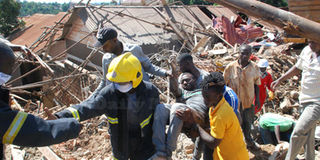Concern over surge in collapsing city buildings

Police and residents carry a man who was rescued from the debris of collapsed building in Kampala last year. PHOTO | FILE
What you need to know:
- The latest incident occurred in Rubaga Division, Kampala, on Monday night.
Tens of people have been killed and others more injured in recent collapsed buildings within Kampala Metropolitan areas, a Daily Monitor mini survey shows.
The survey collected data from a period spanning one year, with the latest collapsed building — a five-storey structure under construction in Rubaga Division (Kitebi Bunamwaya Zone) — claiming one life.
The search for three other people, who were believed to be in the building at the time of the collapse, was still ongoing by press time.
“We thought it was an earthquake but only to wake up, the building had collapsed,” said one of the residents who did not wanted to be identified.
Mr Solomon Balemeezi, an investigations officer from the National Building Review Board (NBRB), said they are in the process of “assess[ing] the cause of the accident.”
Rubaga South MP Aloysius Mukasa says “fights” within Kampala Capital City Authority (KCCA) are partly responsible for the surge in collapsed buildings.
About the latest collapsed building, he said: ”I don’t know whether the structure engineer fulfilled his obligations and duties to fully ascertain the truthfulness of the plan that was issued by KCCA. We also want to know if the site inspector from Rubaga really did his job to inspect this building from its foundation.”
The Kampala Metropolitan deputy police spokesperson, Mr Luke Owoyesigire, said Katwe Police Station is investigating the incident.
“Our police officers visited the scene and found two people who had sustained injuries and one person identified as Kelvin Nyanzi who was found dead,” he said.
Other cases
Six people died on spot after a building collapsed in Kansanga, Makindye Division, on January 9, 2020. Six days later, three people perished after a two-storeyed building located on Plot 17 Gokhale Road caved in. Another building, which collapsed during the same month (January 24), registered no fatalities.
On July 16, 2021, a storeyed building at Kabulengwa in Nansana Municipality collapsed, killing its owner. Earlier, on March 16, 2021, two bodies were pulled out of debris of the Fido Dido building on Kampala Road.
Mr Nicholas Omoding, the manager-in-charge of investigations at NBRB, told Daily Monitor yesterday over the telephone that there will be more stick and less carrot in dealing with the matter.
“We have established a branch office at the office of Directorate of Public Prosecutions called Building Crime Division. It will help us to prosecute anyone who will be found guilty when the building collapses,” he said.
Mr Daniel Nuwabiine, the Kampala Capital City Authority (KCCA) spokesperson, said yesterday that they had long moved to stop the proprietor of the Kitebi building from carrying out construction works.
Mr Nuwabiine said the 42-day Covid-19 induced lockdown made it easy for the developers to defy KCCA orders.
Procedure
Before one embarks on any development in the city, they are supposed to meet certain requirements. These include providing a copy of the land title, search statement of the land title, payment receipts, and survey report from registered surveyor to ascertain open boundaries.
Other requirements include verifying location as well as checking encroachment. To guarantee this, one has to present two copies of architectural drawings signed by a registered and practicing architect.
Other documents to be presented are two copies of structural application certificates signed by a structural engineer, signed structural calculations, a geotechnical report, an excavation plan, a traffic impact mitigation plan, an environmental impact assessment plan and a storm water management plan.
Frustrated developers
According to KCCA’s website, approval of any development plan takes at least two weeks. In reality, though, it may take months due to the already existing backlog.
In such an event of delayed approval, KCCA says the developer can write to the physical planning director to expedite the process.
Mr Edmund Mutatiina, a civil engineer, attributes the rise in collapsed buildings to owners who don’t follow the counsel of site engineers. He said most buildings that have collapsed are commercial and not residential because “clients tend to be mean when it comes to commercial building…they want to take shortcuts.”
Some developers of buildings, who declined to be named, decry the bureaucratic glitches in the approval of plans. One said: “Getting your construction plan approved at KCCA can be so tedious. This affects people who have borrowed money from the banks and have pressure to construct buildings on time.”
What experts say
Mr Edmund Mutatiina, a civil engineer, attributes the rise in collapsed buildings to owners who don’t follow the counsel of site engineers.
He said most buildings that have collapsed are commercial and not residential because “clients tend to be mean when it comes to commercial building…they want to take shortcuts.”
Mr Mutatiina added: “For high-rise buildings, you are supposed to use different sizes of iron bars depending on the foundation and the number of floors. If the site engineer fails to supervise and ascertain whether workers have used the recommended raw materials, workers may end up compromising on the standards.”





